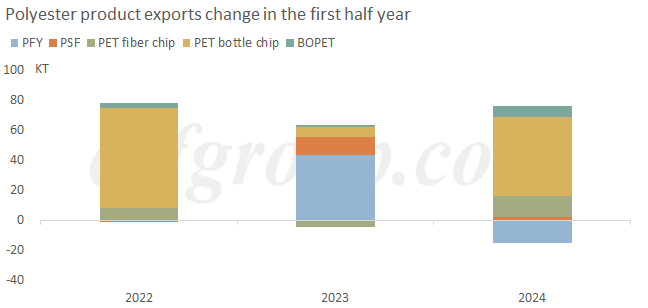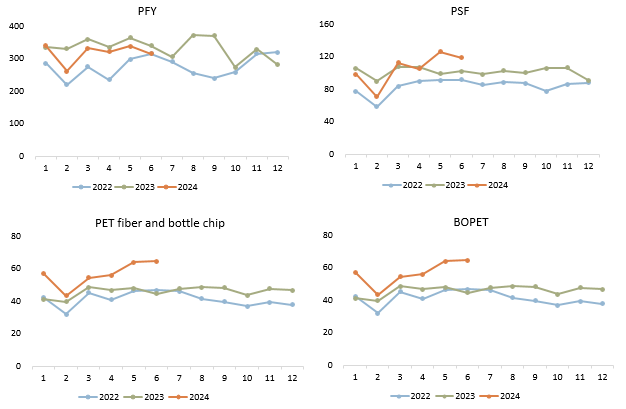Polyester industry chain exports in Jun
According to the latest data released by customs, polyester product exports continued to grow in the first half of 2024, with a noticeable shift in structure from the fiber sector to non-fiber products.
June Polyester Product Export Growth
In June 2024, domestic polyester product exports reached 1.114 million tons, an increase of 246,000 tons year-on-year and 18,000 tons month-on-month.
Among specific product categories, filaments were the only ones to see a year-on-year decline, while bottle-grade PET showed strong performance both year-on-year and month-on-month.
June 2024 Export Volumes and Changes in Polyester Products
| unit: KT | Jun-24 | y-o-y | m-o-m |
| PFY | 315 | -25 | -24 |
| PSF | 118 | 17 | -8 |
| PET fiber chip | 85 | 11 | -12 |
| PET bottle chip | 532 | 223 | 61 |
| BOPET | 64 | 20 | 1 |
| Total | 1114 | 246 | 18 |
Shift in Export Highlights in the First Half of the Year
Overall, from January to June 2024, polyester product exports totaled 6.138 million tons, an increase of 605,000 tons year-on-year. In the first half of 2023, exports were 5.534 million tons, with a year-on-year increase of 591,000 tons.
While the growth volumes for the first half of both years are roughly similar, there has been a clear shift in the growth focus from fibers to non-fiber products this year.

In more detailed terms, not only have PET fiber chip and bottle-grade chip exports performed well, but BOPET exports have also been notable. Over the past two years, BOPET production has steadily increased, with one or two new production lines coming online each year, gradually expanding the export market.
Year-on-Year Growth in Exports of Polyester Products in the First Half of the Year
| unit:KT | 2022 | 2023 | 2024 |
| PFY | -5 | 434 | -156 |
| PSF | -1 | 119 | 21 |
| PET fiber chip | 79 | -44 | 140 |
| PET bottle chip | 668 | 68 | 530 |
| BOPET | 34 | 15 | 70 |
| Polyester | 776 | 591 | 605 |
Below is a comparative annual trend of monthly export volumes for various polyester products. It is clear that filament exports have dropped to a lower level compared to previous years, while staple fiber exports are performing well, and PET fiber chip and bottle-grade chip, as well as BOPET exports, continue to be strong, showing an upward trend. Overall, China's polyester industry remains highly competitive globally.
Monthly Export Trends of Polyester Products (unit: KT)

Filament Export Decline Likely to Continue
The decline in filament exports appears to be primarily due to reduced volumes exported to India, with a general downturn in all categories. The sustainability of this trend remains to be seen. Increases in ocean freight rates in April and May 2024 negatively impacted export orders, while rising filament prices in May and June added further pressure. Currently, ocean freight rates to many countries are gradually decreasing, and we need to monitor subsequent order negotiations. As things stand, a y-o-y decline in filament export volumes seems likely.
Changes in Polyester Filament Exports to India vs. Global
| unit: KT | y-o-y change | m-o-m change | ||
| To India | To Global | To India | To Global | |
| Jan | -39 | 5 | ||
| Feb | -44 | -69 | -5 | -78 |
| Mar | -34 | -28 | -4 | 70 |
| Apr | -31 | -15 | 0 | -11 |
| May | -62 | -25 | 4 | 18 |
| Jun | -29 | -25 | 2 | -24 |
Non-Fiber Exports Alleviate Capacity Pressure
Bottle-grade PET exports rebounded significantly from late last year to the first half of this year, becoming a major driver of demand.
Vietnam, Nigeria, and Indonesia are the primary destinations for fiber grade chip and bottle-grade PET chip exports. In terms of growth, exports to Vietnam and Indonesia have increased by more than 100,000 tons compared to the same period last year.
Top 10 Destinations of China's Fiber-grade and Bottle-grade PET Exports in H1 2024
| unit: KT | H1 2023 | H1 2024 | y-o-y change |
| Vietnam | 104 | 223 | 119 |
| Nigeria | 131 | 187 | 56 |
| Indonesia | 81 | 184 | 103 |
| South Korea | 92 | 149 | 56 |
| UAE | 107 | 145 | 38 |
| Russia | 146 | 138 | -8 |
| India | 89 | 137 | 48 |
| Algeria | 73 | 112 | 39 |
| Philippines | 93 | 104 | 11 |
| Peru | 51 | 80 | 30 |
Since mid-last year, bottle-grade PET has entered a period of concentrated capacity expansion, leading to a substantial compression in price spreads. However, this has relatively enhanced its export competitiveness. Despite facing various barriers such as anti-dumping measures, China's polyester bottle-grade PET remains highly attractive globally. BOPET faces similar challenges, with increasing domestic competition pressure due to the release of new capacity in recent years, resulting in growing export shares. In contrast, the supply-demand balance for filaments has improved this year, with price spreads gradually widening, leading to more divergence in foreign trade price negotiations. Therefore, the shift from fiber to non-fiber export growth this year is somewhat reasonable.
- Top keywords
- Cotton Price
- Cotton Futures Price
- Cotton Futures
- CZCE
- PTA Futures Price
- Chemical Fiber
- Polyester Prices
- Wool price
- PTA Futures
- Shengze Silk
- China
- Yarn Price
- price
- China Textile City
- Fibre Price
- Benzene Price
- Cotton
- Index
- Cotton Index
- PTA
- fabric price
- NYMEX
- Top 10
- textile industry
- Spot Cotton
- Cotton Yarn
- Polyester Price
- Futures
- PTA Price
- cotton yarn price

